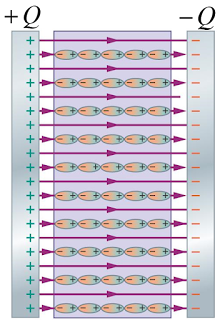|
Consider a
parallel-plate capacitor
· Initially the plates are separated by a vacuum and connected
to a battery, giving the charge on the plates +Q and
–Q
· The battery is now removed and the charge on the
plates remains constant
· The electric field between the plates is uniform and has a
magnitude of E0
· Meanwhile the separation between plates is d
|
· When a dielectric is placed in the electric field between
the plates, the molecules of the dielectric tend to become oriented with their
positive ends pointing toward the negatively charged plate and vice versa
· The result is a buildup of positive
charge on one surface of the dielectric and of negative charge on the other
|
|
· The number of field
lines within the dielectric is reduced thus the applied
electric field E0 is partially
canceled
· The new
electric field, E is electric field between the plates is uniform and has a
magnitude of E0
· The new electric field strength (E < E0)
is less, then the potential difference, V across
the plates is less
V
= Ed
· Since V is smaller while Q remains
the same the capacitance
C
= Q/V
is increased by
the dielectric
|
|
Thursday, December 28, 2017
How dielectric can increase the capacitance of a capacitor?
Charging & discharging of capacitor
As soon as the switch is closed, the battery is connected across the capacitor, current flows and the potential difference across the capacitor begins to rise but, as more and more charge builds up on the capacitor plates, the current and the rate of rise of potential difference both fall. Finally no further current will flow when the p.d. across the capacitor equals that of the supply voltage Vo.
The capacitor is then fully charged.
The capacitor is then fully charged.
Current starts to flow and the potential difference across the capacitor drops.
As charge flows from one plate to the other through the resistor the charge is
neutralised and so the current falls and the rate of decrease of potential
difference also falls. Eventually the charge on the plates is zero and
the current and potential difference are also zero - the capacitor is fully
discharged.
Vbattery = Vresistor + Vcapacitor
Vbattery = IR + Q/C
Wednesday, December 20, 2017
Tuesday, December 19, 2017
Monday, December 18, 2017
ANSWER TECHNIQUE 1
IMPORTANT
|
VECTOR QUANTITY
|
SCALAR QUANTITY
|
|
Electrostatic force, F – Coulomb’s law
|
Electric potential, V
|
|
Electric field, E
|
Work, W
|
|
|
Potential energy, U
|
|
In calculation, NO need to put the sign of charge
|
In calculation, NEED to put the sign of charge either (+)ve or (–)ve
|
Inverse square law
The inverse-square law, is quite common in Physics. This law state that for a specified physical quantity or intensity is inversely proportional to the square of the distance from the source of that physical quantity.
The fundamental cause for this can be understood as geometric dilution corresponding to point-source radiation into three-dimensional space.
Coulomb's law is one of it. Applications of the inverse square law: gravity, sound, light and radiation.
The fundamental cause for this can be understood as geometric dilution corresponding to point-source radiation into three-dimensional space.
Coulomb's law is one of it. Applications of the inverse square law: gravity, sound, light and radiation.
Wednesday, November 29, 2017
Subscribe to:
Posts (Atom)
Infographic
Infographics (a clipped compound of " information " and " graphics ") are graphic visual representations of informati...



















